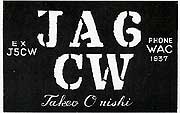An Outline History of
|
|
The history of Japanese HAM radio was completely different before and after World War 2.
The Japanese Government first issued "HAM like" licenses for individual radio stations during 1922. The first licensed individual during that period was named Tsuneharu Hamaji, who lived in Tokyo. He actually had two licenses. Then 25 years later, the Japanese Government established the first public radio station in 1897. During 1924, Kankichi Kusama and 9 other stations were licensed. Their callsigns were JXAX-JXIX. During the above period, "All was under Government control" and common individuals enjoyed few freedoms. If a Japanese station wanted to make a QSO with US Hams, certain documentation requisits were necessary in order to obtain provisional license authorization. This took the form of meeting legal standard criteria in the establishment of a "Private Wireless Telegraphy and Telephone Laboratory" for the purpose of conducting tests. With the completion of provisional documentation and approval...a provisional license was issued, pursuant to officials actually coming to the applicants residence for final documentation and tests for full license authorization. The following criteria needed to be met : operator's ability (TX-RX CW, technical level, knowledge of laws), and reaffirmed wave technical criteria, high-voltage insulation, confirming the antenna position, lightning protection system, earth resistance .....etc. Upon satisfactory completion of all of the above, officials, there upon, made their final determination and gave approval and granted full authorization for the station to begin operation issuing a 1 x 2 callsign. If a comparison is made between the licensing requirements of pre-WW2 and after WW2, the main difference was in regard to the location of where the examinatin occurred. Pre WW2 had the examination at the station, where as after WW2 the examination was administered at an examination center. During the pre-WW2 period, checks made in regard to applicants financial status and background were carefully examined. It is believed that the stringent inspections were in regard to preventing spy activity during that period and often resulted with inspections from special politically orientated police. Of course this type of station was not a "Ham Station" in the true sense of the word, but it was a front runner for future ham radio in that communication with foreign ham stations was allowed for test purposes. If we are to make a comparison between regulations as they existed before WW2 and after WW2,we would need to say that the difference was great. Before WW2, emphasis was on a stations responsibility to conduct tests and make reports, in much the same manner as regular broadcast stations in order to obtain and maintain licensing. The authorized bands were ; 40, 20,10, and 5m(56-60MHz) In 1925, prefixes became J1 thru J9. Then during 1936, the following changes took place..... J2 ..... JA1 - Kanto, JA2-Tokai, JA9 - Hokuriku, JA0 - Shinetu J3 ..... JA3 - Kansai, East part of JA4, East and South part of JA5 J4 ..... West part of JA4, West part of JA5 J5 ..... JA6 - Kyushu, JR6 - Okinawa J6 ..... JA7 - Tohoku J7 ..... JA8 - Hokkaido, UA0F - South part of Sakhalin J8 ..... HL - South Korea, BY9 - Dalian area in China J9 ..... BV - Taiwan, KH0 V6 V7 T8 - South West Pacific MX (Manchurian,--- ITU Non-official recognition) .... BY9 Heilungjiang in China More detail of Japanese Prefix History is there. (English)
The French suggestion invited a bit of derisive laughter from the US contingent. The reason for the laughter was that, "government management of radio stations" was not a system recognized in the US at that time. Of course peace time conditions do not necessarily reflect governmental positions when contrasted with those in times of war. During times of peace, there was no government interference with privately conducted communication as long as radio regulations were adhered to. In contrast, Japan and France, previously and even now, remain more or less "Officialistic" in regard to their type of government. When viewing the history of Ham radio in so far as Japan is concerned, it is helpful to bear the foregoing in mind. This type of "HAM" radio, namely Private Laboratory style stations increased and during the following 10-15 year period resulted in 270 stations. But due to the attack on Pearl Harbor by Japanese forces on Dec.7, 1941 ( Dec.8,1941 Japanese time ) all Japanese stations were ordered to cease transmitting. About one week later, even reception of radio signals was prohibited as well as Japanese JARL publications, so as far as "HAM" radio in Japan was concerned... it no longer existed. During March 10 1945.... a great air raid was made on the Tokyo downtown area resulting in great fire loss, as well as, loss of life... it was at that time that J2OV lost his home as well as documents that he had been entrusted with from the JARL and other sources, all of which pertained to pre WW2 Ham history.... thus records of great historical significance were lost. |



